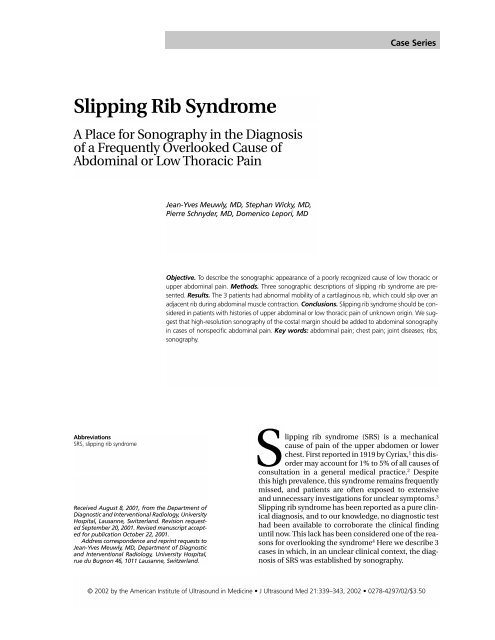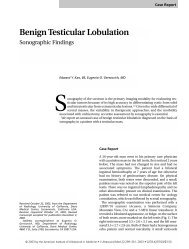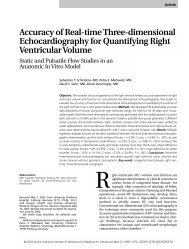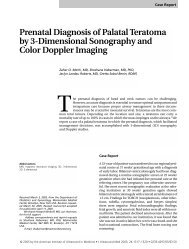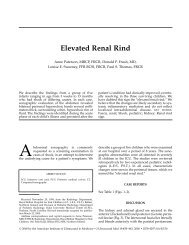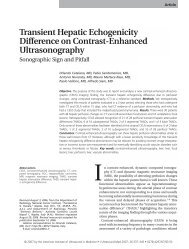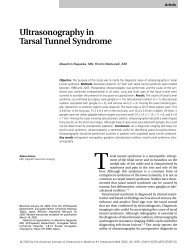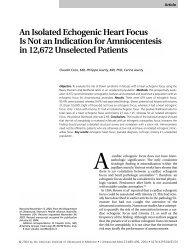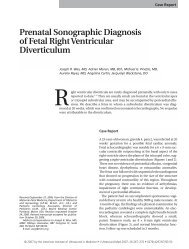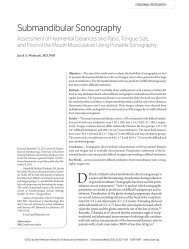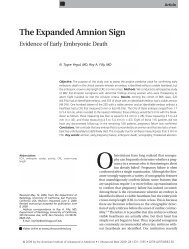Slipping Rib Syndrome - Journal of Ultrasound in Medicine
Slipping Rib Syndrome - Journal of Ultrasound in Medicine
Slipping Rib Syndrome - Journal of Ultrasound in Medicine
You also want an ePaper? Increase the reach of your titles
YUMPU automatically turns print PDFs into web optimized ePapers that Google loves.
<strong>Slipp<strong>in</strong>g</strong> <strong>Rib</strong> <strong>Syndrome</strong><br />
A Place for Sonography <strong>in</strong> the Diagnosis<br />
<strong>of</strong> a Frequently Overlooked Cause <strong>of</strong><br />
Abdom<strong>in</strong>al or Low Thoracic Pa<strong>in</strong><br />
Abbreviations<br />
SRS, slipp<strong>in</strong>g rib syndrome<br />
Received August 8, 2001, from the Department <strong>of</strong><br />
Diagnostic and Interventional Radiology, University<br />
Hospital, Lausanne, Switzerland. Revision requested<br />
September 20, 2001. Revised manuscript accepted<br />
for publication October 22, 2001.<br />
Address correspondence and repr<strong>in</strong>t requests to<br />
Jean-Yves Meuwly, MD, Department <strong>of</strong> Diagnostic<br />
and Interventional Radiology, University Hospital,<br />
rue du Bugnon 46, 1011 Lausanne, Switzerland.<br />
Jean-Yves Meuwly, MD, Stephan Wicky, MD,<br />
Pierre Schnyder, MD, Domenico Lepori, MD<br />
Case Series<br />
Objective. To describe the sonographic appearance <strong>of</strong> a poorly recognized cause <strong>of</strong> low thoracic or<br />
upper abdom<strong>in</strong>al pa<strong>in</strong>. Methods. Three sonographic descriptions <strong>of</strong> slipp<strong>in</strong>g rib syndrome are presented.<br />
Results. The 3 patients had abnormal mobility <strong>of</strong> a cartilag<strong>in</strong>ous rib, which could slip over an<br />
adjacent rib dur<strong>in</strong>g abdom<strong>in</strong>al muscle contraction. Conclusions. <strong>Slipp<strong>in</strong>g</strong> rib syndrome should be considered<br />
<strong>in</strong> patients with histories <strong>of</strong> upper abdom<strong>in</strong>al or low thoracic pa<strong>in</strong> <strong>of</strong> unknown orig<strong>in</strong>. We suggest<br />
that high-resolution sonography <strong>of</strong> the costal marg<strong>in</strong> should be added to abdom<strong>in</strong>al sonography<br />
<strong>in</strong> cases <strong>of</strong> nonspecific abdom<strong>in</strong>al pa<strong>in</strong>. Key words: abdom<strong>in</strong>al pa<strong>in</strong>; chest pa<strong>in</strong>; jo<strong>in</strong>t diseases; ribs;<br />
sonography.<br />
lipp<strong>in</strong>g rib syndrome (SRS) is a mechanical<br />
cause <strong>of</strong> pa<strong>in</strong> <strong>of</strong> the upper abdomen or lower<br />
chest. First reported <strong>in</strong> 1919 by Cyriax, 1 this disorder<br />
may account for 1% to 5% <strong>of</strong> all causes <strong>of</strong><br />
consultation <strong>in</strong> a general medical practice. 2 Despite<br />
this high prevalence, this syndrome rema<strong>in</strong>s frequently<br />
missed, and patients are <strong>of</strong>ten exposed to extensive<br />
and unnecessary <strong>in</strong>vestigations for unclear symptoms. 3<br />
<strong>Slipp<strong>in</strong>g</strong> rib syndrome has been reported as a pure cl<strong>in</strong>ical<br />
diagnosis, and to our knowledge, no diagnostic test<br />
had been available to corroborate the cl<strong>in</strong>ical f<strong>in</strong>d<strong>in</strong>g<br />
until now. This lack has been considered one <strong>of</strong> the reasons<br />
for overlook<strong>in</strong>g the syndrome4 S<br />
Here we describe 3<br />
cases <strong>in</strong> which, <strong>in</strong> an unclear cl<strong>in</strong>ical context, the diagnosis<br />
<strong>of</strong> SRS was established by sonography.<br />
© 2002 by the American Institute <strong>of</strong> <strong>Ultrasound</strong> <strong>in</strong> Medic<strong>in</strong>e • J <strong>Ultrasound</strong> Med 21:339–343, 2002 • 0278-4297/02/$3.50
<strong>Slipp<strong>in</strong>g</strong> <strong>Rib</strong> <strong>Syndrome</strong><br />
Case Reports<br />
Case 1<br />
A 20-year-old cricketer was admitted to the<br />
emergency department with acute pa<strong>in</strong> <strong>in</strong> the<br />
upper right abdomen. This pa<strong>in</strong> occurred<br />
abruptly after abdom<strong>in</strong>al wall overstretch<strong>in</strong>g<br />
dur<strong>in</strong>g a cricket match. At cl<strong>in</strong>ical exam<strong>in</strong>ation,<br />
the right upper abdomen and the <strong>in</strong>ferior anterior<br />
border <strong>of</strong> the thoracic wall were pa<strong>in</strong>ful.<br />
Neither a mass nor sk<strong>in</strong> discoloration could be<br />
observed. Biological test results were normal,<br />
and the patient had no fever. An abdom<strong>in</strong>al wall<br />
sonographic exam<strong>in</strong>ation was performed to rule<br />
out a tear <strong>of</strong> the abdom<strong>in</strong>al muscles. Sonography<br />
with a high-frequency l<strong>in</strong>ear probe (L12-5 with<br />
SonoCT and HDI 5000 systems; Philips <strong>Ultrasound</strong>,<br />
Bothell, WA) showed slipp<strong>in</strong>g <strong>of</strong> the<br />
eighth costal cartilage on the lower edge <strong>of</strong> the<br />
seventh rib, repeatedly triggered by Valsalva<br />
maneuvers (Fig. 1). Dur<strong>in</strong>g contraction <strong>of</strong> the<br />
rectus muscle, the eighth rib was <strong>in</strong>itially displaced<br />
aga<strong>in</strong>st the anterior aspect <strong>of</strong> the lower<br />
border <strong>of</strong> the seventh rib. As the contraction<br />
<strong>in</strong>creased, the eighth rib was suddenly pushed<br />
<strong>in</strong>. Simultaneously, a rebound effect was perceptible<br />
under the probe at the very moment the<br />
patient felt pa<strong>in</strong>. Because the symptoms did not<br />
improve with conservative treatment, surgical<br />
removal <strong>of</strong> the extremity <strong>of</strong> the eighth rib was<br />
performed. The rib was totally normal at pathologic<br />
exam<strong>in</strong>ation. The symptoms disappeared<br />
after the procedure.<br />
Case 2<br />
A 36-year-old nurse had chronic dull pa<strong>in</strong> <strong>in</strong> the<br />
left upper abdomen for 4 months. The pa<strong>in</strong><br />
<strong>in</strong>creased dur<strong>in</strong>g work and subsided at night.<br />
The patient reported that mov<strong>in</strong>g patients was<br />
particularly pa<strong>in</strong>ful. She had no history <strong>of</strong> trauma<br />
or excessive muscular activity. Physical exam<strong>in</strong>ation<br />
proved <strong>in</strong>conclusive. Neither biological<br />
abnormalities nor fever was observed. The<br />
patient had a sonographic exam<strong>in</strong>ation <strong>of</strong> the<br />
abdomen, performed with the high-frequency<br />
l<strong>in</strong>ear probe and systems described above. As the<br />
patient performed a Valsalva maneuver dur<strong>in</strong>g<br />
real-time sonography, slipp<strong>in</strong>g <strong>of</strong> the left n<strong>in</strong>th<br />
rib around the eighth rib was obvious, precisely<br />
<strong>in</strong> the area <strong>of</strong> tenderness. The displacement <strong>of</strong><br />
the n<strong>in</strong>th rib was closely and repeatedly related<br />
to the Valsalva maneuver and contraction <strong>of</strong> the<br />
rectus muscle. A click<strong>in</strong>g <strong>of</strong> the rib as it slipped<br />
was perceptible with the probe. The patient perfectly<br />
understood the explanation about the orig<strong>in</strong><br />
<strong>of</strong> her pa<strong>in</strong> and the symptoms improved<br />
with<strong>in</strong> 2 weeks after the sonographic exam<strong>in</strong>ation<br />
without any further treatment.<br />
Case 3<br />
A 53-year-old man had right upper abdom<strong>in</strong>al<br />
pa<strong>in</strong>, worsened by cough<strong>in</strong>g, for 3 months.<br />
Physical exam<strong>in</strong>ation f<strong>in</strong>d<strong>in</strong>gs were normal, and<br />
there was no biological abnormality. Previous<br />
<strong>in</strong>vestigations <strong>in</strong>cluded gastroscopy, computed<br />
tomography <strong>of</strong> the abdomen, and chest radiography.<br />
Sonography was ordered to rule out a gallbladder<br />
or biliary tree abnormality. Dur<strong>in</strong>g<br />
sonographic exam<strong>in</strong>ation <strong>of</strong> the abdomen,<br />
which revealed neither cholelithiasis nor biliary<br />
disease, the abdom<strong>in</strong>al wall was also explored<br />
with the high-frequency transducer described<br />
above. <strong>Slipp<strong>in</strong>g</strong> <strong>of</strong> the eighth rib around the seventh<br />
rib was visible dur<strong>in</strong>g the Valsalva maneuver<br />
at the moment when the patient felt pa<strong>in</strong>. This<br />
phenomenon was repeatedly reproducible dur<strong>in</strong>g<br />
contraction <strong>of</strong> the abdom<strong>in</strong>al wall muscles.<br />
The diagnosis <strong>of</strong> SRS was made, and the mechanism<br />
was expla<strong>in</strong>ed and shown to the patient by<br />
real-time sonography. Reassurance and explanation<br />
were sufficient for this patient, whose symptoms<br />
disappeared without further treatment.<br />
Discussion<br />
Among causes <strong>of</strong> upper abdom<strong>in</strong>al or lower thoracic<br />
pa<strong>in</strong>, wall disorders are not <strong>in</strong>frequent. 5–7<br />
They have to be recognized so that correct treatment<br />
can be planned rapidly and unnecessary<br />
explorations can be avoided.<br />
Despite the fact that SRS has been described for<br />
decades <strong>in</strong> adults 3,4,8 and children, 9,10 it rema<strong>in</strong>s<br />
poorly recognized. Classically, the pa<strong>in</strong> occurs <strong>in</strong><br />
the upper abdomen or lower chest, above the<br />
costal marg<strong>in</strong>. Although it is <strong>of</strong>ten related to<br />
m<strong>in</strong>or trauma, constra<strong>in</strong>ed posture, or previous<br />
abdom<strong>in</strong>al surgery, the etiology <strong>of</strong> SRS rema<strong>in</strong>s<br />
unclear, because many patients, such as the<br />
patient <strong>in</strong> case 3, did not recall any such<br />
event. 3,8,11 <strong>Slipp<strong>in</strong>g</strong> rib syndrome is usually located<br />
on the right side but may also be noticed on<br />
the left or bilaterally. Variation <strong>in</strong> the <strong>in</strong>tensity <strong>of</strong><br />
pa<strong>in</strong> is frequently related to mechanical conditions,<br />
such as cough<strong>in</strong>g or bear<strong>in</strong>g loads <strong>in</strong> our<br />
cases. <strong>Slipp<strong>in</strong>g</strong> rib syndrome is produced by<br />
imp<strong>in</strong>gement <strong>of</strong> an <strong>in</strong>tercostal nerve between 2<br />
340 J <strong>Ultrasound</strong> Med 21:339–343, 2002
costal cartilages, secondary to the luxation <strong>of</strong> an<br />
<strong>in</strong>terchondral articulation. Indeed, contrary to<br />
the first 7 ribs, which are firmly l<strong>in</strong>ked to the<br />
sternum by sternocostal jo<strong>in</strong>ts, the 8th, 9th, and<br />
10th ribs are attached by <strong>in</strong>terchondral weak<br />
jo<strong>in</strong>ts (Fig. 2). 12,13 Accord<strong>in</strong>g to the orig<strong>in</strong>al<br />
mechanical description, this allows a rib to slip<br />
beh<strong>in</strong>d the rib above it. 1 Our sonographic<br />
observations showed that an overlapp<strong>in</strong>g<br />
movement occurred first, followed by a sudden<br />
slipp<strong>in</strong>g <strong>in</strong> depth <strong>of</strong> the lower rib, with shear<strong>in</strong>g<br />
stress. In a comparative series <strong>of</strong> 6 volunteers<br />
without symptoms, we had never seen this k<strong>in</strong>d<br />
<strong>of</strong> movement. Indeed, the contraction <strong>of</strong><br />
abdom<strong>in</strong>al wall muscle by the Valsalva maneuver<br />
<strong>in</strong>duced a slow driv<strong>in</strong>g <strong>of</strong> the ribs <strong>in</strong> the wall,<br />
with preservation <strong>of</strong> the anatomic relationships<br />
(Fig. 3).<br />
At physical exam<strong>in</strong>ation, the most common<br />
f<strong>in</strong>d<strong>in</strong>g <strong>in</strong> a case <strong>of</strong> SRS is tenderness above the<br />
costal marg<strong>in</strong>. Dur<strong>in</strong>g the Valsalva maneuver, it<br />
is possible to palpate the slipp<strong>in</strong>g <strong>of</strong> the rib as<br />
the abdom<strong>in</strong>al muscles contract. The hook<strong>in</strong>g<br />
maneuver described by He<strong>in</strong>z and Zavala, 14<br />
Meuwly et al<br />
Figure 1. High-resolution sonographic longitud<strong>in</strong>al views <strong>of</strong> the lower right thoracic wall <strong>in</strong> a patient with SRS, with transverse sections <strong>of</strong> the seventh<br />
(*) and eighth (#) ribs, which appear as hypoechoic rounded structures. The arrows depict the movements <strong>of</strong> the ribs. A, At rest, the 2 cartilages lie at<br />
about the same level. B, When rectus muscle (rm) contraction is <strong>in</strong>itiated, the eighth rib moves cranially and overlaps the seventh rib (curved arrow).<br />
C, As the muscle contraction <strong>in</strong>creases, the ribs are slowly pushed down. Suddenly the eighth rib slips along the marg<strong>in</strong> <strong>of</strong> the seventh rib (arrow). This<br />
movement is felt as a click under the f<strong>in</strong>gers <strong>of</strong> the exam<strong>in</strong>er. D, At maximal contraction, the 2 ribs are at the same depth, below the rectus muscle.<br />
E, As the contraction decreases, the eighth rib jumps away from the seventh rib (arrow). F, At rest, the ribs return to their <strong>in</strong>itial locations.<br />
Figure 2. Illustration <strong>of</strong> the anterior view <strong>of</strong> the sternocostal (SCJ), costochondral<br />
(CCJ), and <strong>in</strong>terchondral (ICJ) jo<strong>in</strong>ts. Articulations between costal cartilages <strong>of</strong> the<br />
sixth and seventh, seventh and eighth, and eighth and n<strong>in</strong>th ribs are plane synovial<br />
jo<strong>in</strong>ts with a synovial cavity and a weak articular capsule. Articulation between<br />
costal cartilages <strong>of</strong> the 9th and 10th ribs is fibrous. The position <strong>of</strong> the transducer,<br />
as used <strong>in</strong> Figures 1 and 2 is shown (T).<br />
J <strong>Ultrasound</strong> Med 21:339–343, 2002 341
<strong>Slipp<strong>in</strong>g</strong> <strong>Rib</strong> <strong>Syndrome</strong><br />
Figure 3. High-resolution sonographic longitud<strong>in</strong>al views <strong>of</strong> the lower right thoracic wall <strong>in</strong> a healthy volunteer, with transverse sections <strong>of</strong> the seventh<br />
(*) and eighth (#) ribs. The arrows depict the movements <strong>of</strong> the ribs. A, At rest, the 2 cartilages lie at the same level. B, When rectus muscle (rm) contraction<br />
is <strong>in</strong>itiated, the seventh and eighth ribs move down jo<strong>in</strong>tly (arrows). C, As the muscle contraction <strong>in</strong>creased, the ribs cont<strong>in</strong>ue to be pushed<br />
down together (arrows). D, At maximal contraction, the 2 ribs are at the same depth, below the rectus muscle. E, As the contraction decreases, the 2<br />
ribs move up jo<strong>in</strong>tly (arrow). F, At rest, the ribs return to their <strong>in</strong>itial locations.<br />
consist<strong>in</strong>g <strong>of</strong> manual hook<strong>in</strong>g <strong>of</strong> the costal marg<strong>in</strong><br />
and anterior stretch<strong>in</strong>g, generally produces<br />
a characteristic click<strong>in</strong>g sound and reproduces<br />
the pa<strong>in</strong>.<br />
To our knowledge, until now there has been no<br />
paracl<strong>in</strong>ical procedure available for assessment<br />
<strong>of</strong> the diagnosis <strong>of</strong> the SRS. This lack was reported<br />
by several authors as the ma<strong>in</strong> cause <strong>of</strong><br />
delayed diagnosis, 2,15 which can result <strong>in</strong> unnecessary<br />
and sometimes <strong>in</strong>vasive <strong>in</strong>vestigations<br />
and prolonged periods <strong>of</strong> <strong>in</strong>effective treatment.<br />
The normal anatomic characteristics <strong>of</strong> costal<br />
cartilages on sonography has been described<br />
well by Choi et al. 16 They showed that <strong>in</strong>terchondral<br />
jo<strong>in</strong>ts could be precisely depicted with<br />
sonography and that sequential scann<strong>in</strong>g<br />
allowed an accurate count <strong>of</strong> them. Furthermore,<br />
we observed that, with high-resolution<br />
sonography <strong>of</strong> the thoracic wall, the luxation <strong>of</strong><br />
the cartilag<strong>in</strong>ous rib can be shown accurately.<br />
Sonography may also exclude other causes <strong>of</strong><br />
thoracic pa<strong>in</strong>, such as rib fractures, 17 Tietze syndrome,<br />
18 abscesses, 19 metastases, 20 muscle tears,<br />
pleuritis, and abdom<strong>in</strong>al diseases.<br />
Because SRS usually does not require any treatment<br />
other than comfort<strong>in</strong>g and explanation <strong>of</strong><br />
the physiopathologic process, real-time sonography<br />
can be used as an <strong>in</strong>formative tool, which<br />
helps the patient understand the mechanism <strong>of</strong><br />
the disorder. In 2 cases reported here, the<br />
patients were completely reassured by the explanation<br />
and the real-time visual demonstration <strong>of</strong><br />
their slipp<strong>in</strong>g rib phenomenon. However, if the<br />
cl<strong>in</strong>ical condition does not improve, s<strong>in</strong>gle or<br />
repeated local anesthetic treatment is usually<br />
curative. 15 In a case <strong>of</strong> failure <strong>of</strong> the medical treatment,<br />
as <strong>in</strong> case 1, surgical removal <strong>of</strong> the rib may<br />
be necessary. 21<br />
References<br />
1. Cyriax E. On various conditions that may simulate<br />
the referred pa<strong>in</strong>s <strong>of</strong> visceral disease and a consideration<br />
<strong>of</strong> these from the po<strong>in</strong>t <strong>of</strong> view <strong>of</strong> cause and<br />
effect. Practitioner 1919; 102:314–322.<br />
2. Wright J. <strong>Slipp<strong>in</strong>g</strong>-rib syndrome. Lancet 1980; 2:632–<br />
634.<br />
342 J <strong>Ultrasound</strong> Med 21:339–343, 2002
3. Lum-Hee N, Abdulla A. <strong>Slipp<strong>in</strong>g</strong> rib syndrome: an<br />
overlooked cause <strong>of</strong> chest and abdom<strong>in</strong>al pa<strong>in</strong>. Int<br />
J Cl<strong>in</strong> Pract 1997; 51:252–253.<br />
4. Barki J, Blanc P, Michel J, et al. Pa<strong>in</strong>ful rib syndrome<br />
(or Cyriax syndrome): study <strong>of</strong> 100 patients [<strong>in</strong><br />
French]. Presse Med 1996; 25:973–976.<br />
5. G<strong>in</strong>aldi S, Spigelian hernia. Ann Emerg Med 1987;<br />
16:455–458.<br />
6. Kl<strong>in</strong>gler P, Oberwalder M, Riedmann B, DeVault K.<br />
Rectus sheath hematoma cl<strong>in</strong>ically masquerad<strong>in</strong>g as<br />
sigmoid diverticulitis. Am J Gastroenterol 2000;<br />
95:555–556.<br />
7. Roberge R, Kantor W, Scorza L. Rectus abdom<strong>in</strong>is<br />
endometrioma. Am J Emerg Med 1999; 17:675–<br />
677.<br />
8. Arroyo JF, V<strong>in</strong>e R, Reynaud C, Michel JP. <strong>Slipp<strong>in</strong>g</strong> rib<br />
syndrome: don’t be fooled. Geriatrics 1995; 50:<br />
46–49.<br />
9. Porter GE. <strong>Slipp<strong>in</strong>g</strong> rib syndrome: an <strong>in</strong>frequently<br />
recognized entity <strong>in</strong> children: a report <strong>of</strong> 3 cases and<br />
review <strong>of</strong> the literature. Pediatrics 1985; 76:810–<br />
813.<br />
10. Mooney DP, Shorter NA. <strong>Slipp<strong>in</strong>g</strong> rib syndrome <strong>in</strong><br />
childhood. J Pediatr Surg 1997; 32:1081–1082.<br />
11. Spence EK, Rosato EF. The slipp<strong>in</strong>g rib syndrome.<br />
Arch Surg 1983; 118:1330–1332.<br />
12. Taddei A, Sick H. Anterior jo<strong>in</strong>ts <strong>of</strong> the thoracic cage<br />
[<strong>in</strong> French]. Arch Anat Histol Embryol 1983;<br />
66:3–53.<br />
13. Moore K, Dalley A. Cl<strong>in</strong>ically Oriented Anatomy.<br />
Philadelphia, PA: Lipp<strong>in</strong>cott Williams & Wilk<strong>in</strong>s;<br />
1999.<br />
14. He<strong>in</strong>z G, Zavala D. <strong>Slipp<strong>in</strong>g</strong> rib syndrome: diagnosis<br />
us<strong>in</strong>g the “hook<strong>in</strong>g maneuver.” JAMA 1977; 237:<br />
794–795.<br />
15. Abbou S, Herman J. <strong>Slipp<strong>in</strong>g</strong> rib syndrome.<br />
Postgrad Med 1989; 86:75–78.<br />
16. Choi YW, Im JG, Song CS, Lee JS. Sonography <strong>of</strong><br />
the costal cartilage: normal anatomy and prelim<strong>in</strong>ary<br />
cl<strong>in</strong>ical application. J Cl<strong>in</strong> <strong>Ultrasound</strong> 1995;<br />
23:243–250.<br />
17. Bitschnau R, Gehmacher O, Kopf A, Scheier M,<br />
Mathis G. <strong>Ultrasound</strong> diagnosis <strong>of</strong> rib and sternum<br />
fractures [<strong>in</strong> German]. Ultraschall Med 1997; 18:<br />
158–161.<br />
18. Mart<strong>in</strong>o F, D’Amore M, Angelelli G, Macar<strong>in</strong>i L,<br />
Cantatore FP. Echographic study <strong>of</strong> Tietze’s syndrome.<br />
Cl<strong>in</strong> Rheumatol 1991; 10:2–4.<br />
19. Sidhu PS, Rich PM. Sonographic detection and characterization<br />
<strong>of</strong> musculoskeletal and subcutaneous<br />
tissue abnormalities <strong>in</strong> sickle cell disease. Br J Radiol<br />
1999; 72:9–17.<br />
20. Mathis G. Thoraxsonography—part I: chest wall<br />
and pleura. <strong>Ultrasound</strong> Med Biol 1997; 23:<br />
1131–1139.<br />
21. Copeland G, Mach<strong>in</strong> D, Shennan J. Surgical treatment<br />
<strong>of</strong> the slipp<strong>in</strong>g rib syndrome. Br J Surg 1984;<br />
71:522–523.<br />
Meuwly et al<br />
J <strong>Ultrasound</strong> Med 21:339–343, 2002 343


